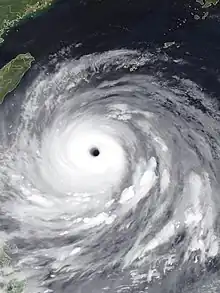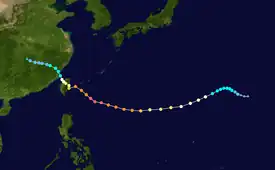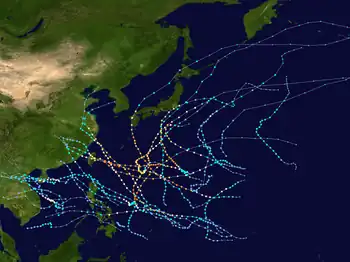Typhoon Haitang (2005)
Typhoon Haitang, known in the Philippines as Typhoon Feria, was the first super typhoon of the 2005 season in the northwestern Pacific. It had winds up to 260 km/h (160 mph) at peak intensity, and caused over 18 serious injuries and 15 confirmed deaths in Taiwan and the People's Republic of China.[1] Damage totaled about $1.17 billion (2005 USD), most of which occurred in mainland China.
 Haitang at peak intensity on July 16 | |
| Meteorological history | |
|---|---|
| Formed | July 11, 2005 |
| Dissipated | July 20, 2005 |
| Violent typhoon | |
| 10-minute sustained (JMA) | |
| Highest winds | 195 km/h (120 mph) |
| Lowest pressure | 920 hPa (mbar); 27.17 inHg |
| Category 5-equivalent super typhoon | |
| 1-minute sustained (SSHWS/JTWC) | |
| Highest winds | 260 km/h (160 mph) |
| Lowest pressure | 898 hPa (mbar); 26.52 inHg |
| Overall effects | |
| Fatalities | 15 total |
| Damage | $1.17 billion (2005 USD) |
| Areas affected | Ryūkyū Islands, Taiwan, China |
| IBTrACS | |
Part of the 2005 Pacific typhoon season | |
Meteorological history

Tropical storm (39–73 mph, 63–118 km/h)
Category 1 (74–95 mph, 119–153 km/h)
Category 2 (96–110 mph, 154–177 km/h)
Category 3 (111–129 mph, 178–208 km/h)
Category 4 (130–156 mph, 209–251 km/h)
Category 5 (≥157 mph, ≥252 km/h)
Unknown
The system formed on the evening of July 11 as a poorly organized depression about 280 km (150 nmi) west of Marcus Island, Japan at 1200 UTC (2100 JST). By 1800 UTC (0300 JST July 13), it had reached a high, destructive tropical storm strength and was named Haitang, a Chinese name for flowering crabapple. It grew to typhoon strength at 1800 UTC (0300 JST July 14) the following day. As it moved westward it continued to gain in strength, intensifying into a Category 3 as it entered the Philippine area of responsibility. Philippine Atmospheric, Geophysical and Astronomical Services Administration (PAGASA) named the storm Feria for Philippine warnings on July 15. By July 16, the storm continued tracking west and became a threat to Taiwan and Japan's Sakishima Islands. Haitang strengthened into a Category 5 super typhoon. On July 17 it weakened to a Category 3 as it continued west, sparing Sakishima a direct hit but aiming directly for Taiwan. Haitang made landfall near Hualien City, Taiwan at 0000 UTC (0800 NST) on the morning of July 18. Taking a full day to cross the island and it caused flash floods and landslides as it passed over the interior mountains. Weakening to a tropical storm as it entered the South China Sea, it reorganized into a minimal typhoon as it approached the southeast China coast. Haitang made landfall for the second time near Wenzhou. China on July 19 at 1200 UTC (2000 CST). Moving inland, it rapidly lost its strength and dissipated. PAGASA stopped issuing advisories for the storm near Jiangxi on July 20.
Impact
Taiwan
In Taiwan, 2 women were found dead east of Taipei, a man was killed by falling rocks, and a fourth victim was swept away by water while fishing. Businesses and schools across Taiwan were ordered closed on July 18 due to the typhoon. More than 1,500 people had been evacuated, mostly from northern Taiwan, and signs of devastation could be seen such as uprooted trees, high waves and loss of electric power.
See also
References
- "Typhoon Leaves 15 Dead in China, Taiwan". July 20, 2005. Retrieved October 13, 2023.
- 新华网 (July 20, 2005). 温州受台风海棠重创受灾人口达441万 (in Chinese). 新浪网. Retrieved June 25, 2009.
- 河南报业网 (July 25, 2005). 台风海棠造成郑州损失3.49亿约15万人受灾 (in Chinese). 新浪网. Retrieved June 25, 2009.
- 都市快报 (July 22, 2005). 台风海棠造成浙江经济损失上升至72.2亿元 (in Chinese). 新浪网. Retrieved June 25, 2009.
- 第一财经日报 (July 21, 2005). 台风海棠造成福建浙江直接经济损失达80多亿 (in Chinese). 枣庄廉政信息网版权所有. Archived from the original on July 7, 2011. Retrieved June 25, 2009.
External links
- JMA General Information of Typhoon Haitang (0505) from Digital Typhoon
- JMA Best Track Data of Typhoon Haitang (0505) (in Japanese)
- JMA Best Track Data (Graphics) of Typhoon Haitang (0505)
- JMA Best Track Data (Text)
- JTWC Best Track Data of Super Typhoon 05W (Haitang)
- 05W.HAITANG from the U.S. Naval Research Laboratory
- BBC news article (Taiwan)
- BBC news article (China)
- Reuters article
- CBC article
- Guardian Unlimited
- Xinhua (China)
